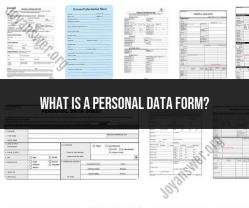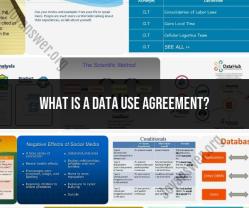What is a personal data form?
A personal data form is a document or electronic form used to collect essential information about an individual. It is typically used by organizations, institutions, or employers to gather necessary data from individuals for various purposes, such as enrollment, employment, membership, or record-keeping. The purpose of a personal data form is to efficiently and systematically collect accurate and relevant information about an individual.
The content of a personal data form may vary depending on its intended use, but it typically includes fields for information such as:
Personal Information: This section typically includes fields for the individual's full name, date of birth, gender, and contact details (address, phone number, email address).
Identification: Information such as social security number, passport number, driver's license number, or other government-issued identification may be requested, depending on the purpose of the form.
Education: For educational institutions or employers, this section may include fields for educational background, degrees earned, schools attended, and academic achievements.
Employment History: If the form is for employment purposes, it may request details about an individual's work experience, including previous employers, job titles, dates of employment, and responsibilities.
Emergency Contacts: Information about individuals to contact in case of an emergency, including their names and contact numbers.
Health Information: In some cases, especially for medical or insurance-related forms, individuals may be asked to provide health-related information.
Financial Information: For financial institutions or applications, information related to income, financial history, or credit checks may be included.
Consent and Authorization: Individuals may be asked to provide consent for the organization to use their data for specific purposes, such as background checks or marketing communications.
Signature and Date: A section where the individual can sign and date the form to confirm the accuracy of the information provided and acknowledge their consent, if applicable.
It's important to note that organizations collecting personal data must comply with data protection and privacy laws and regulations to ensure the security and confidentiality of the information collected. Depending on the jurisdiction, individuals may have certain rights regarding their personal data, such as the right to access, correct, or delete their information.
Personal data forms are a common tool for efficiently gathering information needed for various purposes, but organizations must handle the collected data responsibly and in compliance with legal requirements to protect individuals' privacy and rights.
The Significance of Personal Data Forms in Data Collection
Personal data forms are a significant tool for data collection. They allow organizations to collect information about individuals, such as their name, address, email address, and phone number. This information can be used for a variety of purposes, such as providing services, marketing products, or conducting research.
Personal data forms are important because they allow organizations to collect accurate and up-to-date information about their customers and clients. This information can then be used to improve the quality of services and products, and to develop more targeted marketing campaigns.
Personal data forms can also be used to collect data for research purposes. This data can be used to study trends, identify patterns, and develop new products and services.
Navigating Personal Data Forms: Purpose and Usage
Personal data forms are typically used to collect information for one or more of the following purposes:
- To provide services: Organizations may collect personal data in order to provide services to their customers or clients. For example, a bank may collect personal data from its customers in order to open a bank account or provide a loan.
- To market products: Organizations may collect personal data in order to market their products to potential customers. For example, a clothing retailer may collect personal data from its customers in order to send them email coupons or promotional offers.
- To conduct research: Organizations may collect personal data in order to conduct research on their customers or clients. For example, a research company may collect personal data from individuals in order to study their shopping habits or political views.
When you fill out a personal data form, it is important to read the form carefully and understand how your information will be used. You should only provide information that you are comfortable with the organization using.
Simplifying Data Gathering: How to Fill Out a Personal Data Form
Filling out a personal data form can be a simple process. Here are a few tips:
- Read the form carefully: Before you start filling out the form, read it carefully to understand what information is being requested.
- Provide accurate information: Be sure to provide accurate information on the form. This will help to ensure that the organization has the correct information about you.
- If you have any questions, ask: If you have any questions about the form, do not hesitate to ask the organization for clarification.
Here are some additional tips for filling out personal data forms:
- Use a valid email address and phone number: This will help the organization to contact you if they need to.
- Be specific in your answers: Avoid using vague or general answers when filling out the form.
- Be careful about sharing personal information: Only share personal information that you are comfortable with the organization using.
- Review your answers before submitting the form: Once you have finished filling out the form, be sure to review your answers before submitting it.
By following these tips, you can simplify the data gathering process and ensure that your personal information is used in a responsible and appropriate manner.





